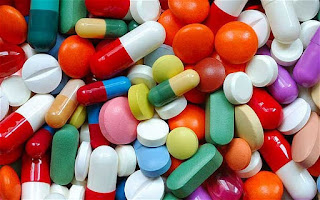Doxycyclin
Trade names: Doxylin, Doxypal, Doxypharm, Doxacylin. Apo-
Doxy, Doryx,
Doxy-Caps, Doxycin
Doxychel Hyclate, Doxytec, Novo-Doxylin ,
Nu-
Doxycycline
,Vibra-Tabs, Vibramycin Class:
Antibiotic, tetracycline. Pregnancy: (Category D)
Therapeutic actions
Bacteriostatic: inhibits
protein synthesis of susceptible bacteria, causing cell death
Indications
•
Infections
caused by rickettsiae; M. pneumoniae; agents of psittacosis, ornithosis,
lymphogranuloma venereum and granuloma inguinale; B. recurrentis; H. ducreyi;
P. pestis; P. tularensis; B. bacilliformis; Bacteroides; V. comma; V. fetus;
Brucella; E. coli; E.
aerogenes; Shigella; A. calcoaceticus; H. influenza; Klebsiella; D.
pneumoniae; S. aureus When penicillin is contraindicated, infections caused
by N. gonorrhoeae, T. pallidum, T.
pertenue, L. monocytogenes, Clostridium, B.
anthracis; adjunct to amebicides in acute intestinal amebiasis
•
Oral tetracyclines used for
acne, uncomplicated adult urethral, endocervical or
rectal infections caused by C. trachomatis
• Unlabeled use: prevention of "traveler's diarrhea"
commonly caused by enterotoxigenic E.
coli
Contraindications/cautions
v
Allergy to tetracyclines,
v
renal or hepatic
dysfunction, v pregnancy, and v
Lactation.
Dosage form:
Available Forms: Tablets--100 mg; powder
for oral suspension--25 mg; syrup--50 mg; powder for injection--100, 200 mg
Dose:
§ 200
mg on first day, then 100 mg daily; severe infections
(including refractory urinary-tract infections), 200 mg daily
§ Early syphilis, 100 mg twice
daily for 14 days; late latent syphilis 200 mg twice daily for 28 days
§ Uncomplicated genital Chlamydia,
non-gonococcal urethritis, 100 mg twice daily for 7 days (14 days in
pelvic inflammatory disease
§
Anthrax
(treatment or post-exposure prophylaxis 100 mg twice daily;
§ Child (only if alternative
antibacterial cannot be given) [unlicensed dose] 5 mg/kg daily in 2 divided
doses (max. 200 mg daily) § Geriatric or Renal Failure Patients:
IV doses of doxycycline are not as toxic as other
tetracyclines in these patients.
Adverse effects
•
GI:
Fatty liver, liver failure, anorexia, nausea, vomiting, diarrhea, glossitis,
dysphagia, enterocolitis, esophageal ulcer
•
Hematologic:
Hemolytic anemia, thrombocytopenia, neutropenia, eosinophilia, leukocytosis,
leukopenia
• Dermatologic: Phototoxic
reactions, rash, exfoliative dermatitis (more frequent and more severe with
this tetracycline than with any others)
• Dental: Discoloring and
inadequate calcification of primary teeth of fetus if used by pregnant women,
discoloring and inadequate calcification of permanent teeth if used during
period of dental development
• Local: Local irritation at
injection site
• Other: Super infections,
nephrogenic diabetes insipidus syndrome
Clinically important interactions
• Drug-drug
• Decreased absorption with antacids, iron, alkali
• Decreased therapeutic effects with barbiturates, carbamazepine,
phenytoins
• Increased digoxin toxicity with doxycycline
• Increased nephrotoxicity with methoxyflurane
• Decreased activity of penicillins
• Drug-food
• Decreased effectiveness of doxycycline if taken with food, dairy
products
• Drug-lab test
• Interference with culture studies for several days following
therapy
Nursing
consideration:
• Administer the oral medication without regard to food or meals;
if GI upset occurs, give with meals.
• Do not give with antacid, milk, or any product that contains
Calcium, Zink, aluminum, magnesium, and ferrous salts, because these products
decrease the absorption of the drug.
• Protect patient from light and sun exposure.
• Report rash, itching; difficulty breathing; dark urine or
light-colored stools; pain at injection site



